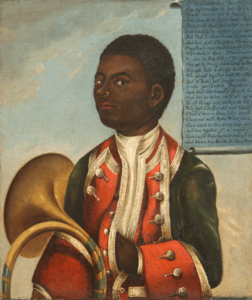Ignatius Sancho and Music: An Overview

Ignatius Sancho is best known today as the author of an extensive correspondence. While a few of his letters were published during his lifetime, most were assembled and published posthumously by a group of his friends as Letters of the Late Ignatius Sancho, an African (1782). What were published during Sancho’s lifetime—apparently with his involvement and oversight—were at least five volumes of original musical compositions, which appeared between 1767 and 1779, the last just a year before his death. Included in his published music are five collections of instrumental dance pieces and one volume of songs:
-
- [Ignatius Sancho], Minuets, Cotillions & Country Dances for the Violin, Mandolin, German-Flute, & Harpsichord (London: the Author, [1767]).
- [Ignatius Sancho], A Collection of New Songs Composed by an African (S.l.: the Author,[1769 or after]).
- [Ignatius Sancho], Minuets &c. &c. for the Violin, Mandolin, German-Flute, and Harpsichord. . . Book 2d (London: printed for the Author and sold by Rich[ar]d Duke, [c. 1770]).
- Ignatius Sancho, Cotillions &c. Humbly Dedicated with Permission to the Princess Royal (London: C. & S. Thompson, [1776]).
- Ignatius Sancho, Twelve Country Dances for the Year 1779. Set for the Harpsichord (London: S. and A. Thompson, 1779).
All these volumes except Cotillions &c. were published in facsimile in Ignatius Sancho (1729–1780): An Early African Composer in England: The Collected Editions of his Music in Facsimile, ed. with intro. by Josephine R. B. Wright (New York: Garland, 1981). Cotillions &c. was rediscovered after the publication of Wright’s edition, but it can be viewed online through the Harvard University Libraries.
Despite these points, Sancho’s music raises as many questions as it answers. First, we know very little of his musical education and practice. What instrument or instruments did he play? With whom, and in what contexts, did he perform? We can make some educated guesses, and some of these can be found in the essays presented here, but little firm evidence survives to provide definitive answers.
Sancho stands out as one of only a few Black composers whose work was published before the nineteenth century. But what did it mean for a Black musician to compose, and why were there so few Black composers? Musicologists have recently studied the ways in which the category of “composer” has been racialized, designed to sort musicians into those with an authorial voice and those without. With most Black musicians (and most women) denied access to the education that would equip them to compose music in the standard forms and styles prevalent in public concerts and upper-class circles, it is no wonder that nearly all composers of the eighteenth century were white men. Musical cultures outside the European classical tradition (including many traditions of popular music dating back to the eighteenth century) do not draw such sharp distinctions between composers and non-composers. Instead, many view the act of musical creation as synonymous with the act of performance.
By piecing together evidence from Sancho’s compositions and his letters—and, crucially, by performing Sancho’s music—the essays and audio-visual materials in this section present new understandings of Sancho’s approaches and agendas as a composer and a musical person. Sancho asserted his authorial voice, to be sure, but he also used his compositions and his correspondence to point beyond his own musical practice to shed light on the musicianship of Black people in his world. You are invited to click on the links below to find out how.